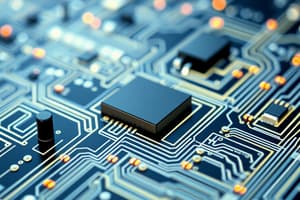Podcast
Questions and Answers
What role does the Zero output of the ALU play in determining the PC value in a RISC-V architecture?
What role does the Zero output of the ALU play in determining the PC value in a RISC-V architecture?
The Zero output of the ALU determines whether the PC is updated to PC + 4 or the branch destination address.
What are the implications of using a single long clock cycle for every instruction in processor design?
What are the implications of using a single long clock cycle for every instruction in processor design?
It simplifies understanding but is impractical as it requires a stretched clock cycle to accommodate the longest instruction.
How does the regularity of the RISC-V instruction set contribute to the control process?
How does the regularity of the RISC-V instruction set contribute to the control process?
The regularity of the RISC-V instruction set allows for a simple decoding process to set the control lines.
What is the main focus of sections 4.3 and 4.4 in the context of computer architecture?
What is the main focus of sections 4.3 and 4.4 in the context of computer architecture?
What is the importance of reviewing digital logic ideas in the design of a computer as mentioned in the text?
What is the importance of reviewing digital logic ideas in the design of a computer as mentioned in the text?
What is the primary characteristic that differentiates combinational elements from state elements in a RISC-V implementation?
What is the primary characteristic that differentiates combinational elements from state elements in a RISC-V implementation?
Describe the role of the clock in state elements of a RISC-V implementation.
Describe the role of the clock in state elements of a RISC-V implementation.
Give two examples of state elements used in RISC-V implementations and explain their significance.
Give two examples of state elements used in RISC-V implementations and explain their significance.
What happens to the information in state elements when power is lost in a computer?
What happens to the information in state elements when power is lost in a computer?
How does a D-type flip-flop function as a state element in the context of RISC-V architecture?
How does a D-type flip-flop function as a state element in the context of RISC-V architecture?
What is the primary characteristic that defines sequential logic components?
What is the primary characteristic that defines sequential logic components?
Why is it crucial to specify the timing of reads and writes in clocking methodologies?
Why is it crucial to specify the timing of reads and writes in clocking methodologies?
How does an edge-triggered clocking methodology operate?
How does an edge-triggered clocking methodology operate?
What is the role of state elements in the context of combinational logic?
What is the role of state elements in the context of combinational logic?
What problem arises if a signal is written at the same time it is read?
What problem arises if a signal is written at the same time it is read?
Flashcards
RISC-V instruction set
RISC-V instruction set
A reduced instruction set computer architecture that uses a simple decoding process to determine how to set control lines.
Control lines
Control lines
Signals that instruct different parts of the processor on what actions to take.
Clock cycle
Clock cycle
A unit of time used to synchronize the execution of instructions.
Single long clock cycle
Single long clock cycle
Signup and view all the flashcards
Branch destination address
Branch destination address
Signup and view all the flashcards
Zero output of ALU
Zero output of ALU
Signup and view all the flashcards
beQ instruction
beQ instruction
Signup and view all the flashcards
Combinational element
Combinational element
Signup and view all the flashcards
State element
State element
Signup and view all the flashcards
Operational Element
Operational Element
Signup and view all the flashcards
State Element Inputs
State Element Inputs
Signup and view all the flashcards
State Element Output
State Element Output
Signup and view all the flashcards
D-type flip-flop
D-type flip-flop
Signup and view all the flashcards
Memory (state element)
Memory (state element)
Signup and view all the flashcards
Register (state element)
Register (state element)
Signup and view all the flashcards
Sequential Logic Components
Sequential Logic Components
Signup and view all the flashcards
Registers
Registers
Signup and view all the flashcards
Clocking Methodology
Clocking Methodology
Signup and view all the flashcards
Edge-Triggered Clocking
Edge-Triggered Clocking
Signup and view all the flashcards
Combinational Logic
Combinational Logic
Signup and view all the flashcards
State elements
State elements
Signup and view all the flashcards
Clock edge
Clock edge
Signup and view all the flashcards
Study Notes
Logic Design Conventions
- To design a computer, decide how the hardware logic will operate and how it will be clocked
- Appendix A provides helpful background in digital logic
- Datapaths consist of two types of logic elements: combinational and state elements
- Combinational elements' outputs depend only on current inputs, producing the same output for the same input
- ALU (Arithmetic Logic Unit) is an example of a combinational element
- State elements have internal storage, maintaining their values even if power is lost
- State elements, for example, instruction and data memories, and registers, characterize the computer
- Restarting the computer involves loading the state elements with their previous values
Clocking Methodology
- A clocking methodology defines when signals can be read and written
- Timing of reads and writes is critical because unpredictable results may occur if a signal is read and written at the same time
- Edge-triggered clocking is used for predictability
- State elements update only on clock edges (transitions from low to high or high to low)
- Combinational logic must have its inputs from state elements and outputs written into state elements
- Inputs are values from the previous clock cycle
- Outputs are used in following clock cycles
Control Signals
- Control signals are used for multiplexor selection or to direct a functional unit's operation
- Control signals are distinct from data signals, which contain information operated on by the functional unit
- "Asserted" means a signal is logically high (true)
- "Deasserted" means a signal is logically low (false)
State Elements and Combinational Logic
- State elements have at least two inputs (data value and clock) and one output
- The clock determines when a data value is written
- Output from a state element provides the value from the prior clock cycle
- Sequential logic components have outputs depend on both their inputs and their internal states
- Edge-triggered methodology allows reading, processing with combinational logic, and writing to a state element within a single clock cycle
- Feedback within a single clock cycle is avoided due to the edge-triggered timing methodology
- 32-bit data paths and buses are employed in RISC-V designs
Register File
- Register files can be read and written in the same clock cycle
- Edge-triggered write requires multiple copies of the register file due to read/write operations occurring in the same clock cycle
- 64-bit versions of RISC-V also exist
Studying That Suits You
Use AI to generate personalized quizzes and flashcards to suit your learning preferences.




